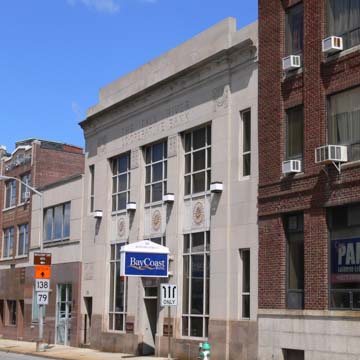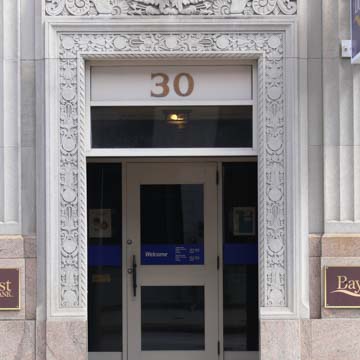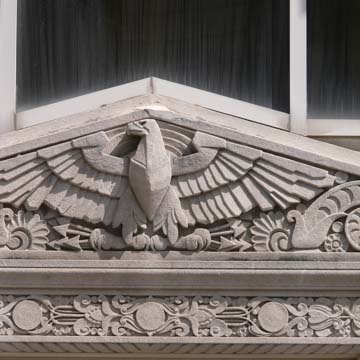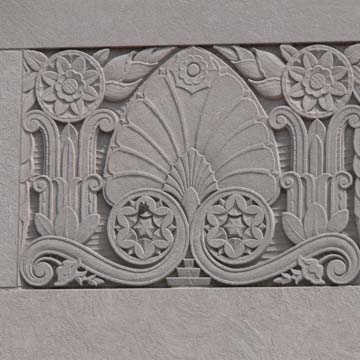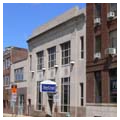This small but elegant Art Deco bank in downtown Fall River stands as poignant reminder of the city’s evolution from a small eighteenth-century settlement to one of the nation’s—and the world’s—largest nineteenth-century industrial centers. Contemporary visitors to the bank, though, will confront a city seeking to redefine itself in a postindustrial age and a downtown whose fabric was badly ruptured by the construction of an interstate highway in the 1960s. Architect Maude Darling-Parlin designed this centrally located financial institution in 1929, a time when sexist prejudices limited most of the few practicing women architects to residential projects.
Thinly populated during the colonial period, Fall River never developed into a major seaport like nearby New Bedford and Providence, Rhode Island, due to the town’s steep, rocky slopes that bordered Mount Hope Bay. The small Quequechan River once flowed through town and its cascades gave the city its name. While Fall River’s geography limited maritime trade, it endowed the town with wealth derived from one of the early industrial age’s most important assets: water power. By 1813 businessmen had created the first cotton mills on the Quequechan River, utilizing the steep grade to great effect.
The textile industry grew meteorically in Fall River over the course of the nineteenth century. By 1850, mills exploited the entirety of the Quequechan River’s flow. Fall River incorporated as a city in 1854, and it surpassed Lowell as the largest textile producer in the nation by 1860. At the century’s end, Fall River produced approximately 70 percent of all the printed cloth manufactured in the United States. As industry altered the physical fabric of the city, an influx of workers changed its cultural character from a small English settlement to one of the state’s most ethnically diverse settlements by the end of the nineteenth century, with Irish, Portuguese, Jewish, and other groups employed at the mills.
Fall River’s financial institutions, such as the Fall River Cooperative Bank, were also a crucial element of the city’s textile boom. Banks underpinned the creation of mills by extending credit and providing the capital that allowed the industry’s vast expansion. Manufacturers established the first banks in the city in the 1820s. The Fall River Cooperative Bank formed in 1888, at the apex of textile manufacturing in Fall River. Bank owners sought to express their businesses’ prominence and durability through their architecture. Many of the city’s early banks were imposing and impressively detailed Victorian and, later, Classical Revival edifices that spoke to the financiers’ wealth, taste, and staying power.
The Fall River Cooperative Bank’s earlier building was destroyed in a 1928 fire that devastated downtown Fall River. The bank commissioned Darling-Parlin to build a new edifice on Bedford Street. The two-story limestone facade features low-relief, restrained yet graceful Art Deco ornamentation. Fluted pilasters rise between the three metal window units that span the facade’s height. Pressed metal spandrels lie between the first and second floors and still bear the original bank’s initials in gold leaf—the only deviation from the building’s muted white and gray color scheme. A striking eagle fills the pediment over the central entrance.
Darling-Parlin executed the design of Fall River Cooperative Bank at a critical moment in Fall River’s history, just before the impact of the Great Depression ended any hopes for city’s economic recovery following its precipitous decline in the early 1920s. Except for a brief resurgence during World War I, the textile industry declined in the twentieth century. Not only had the price of cloth been collapsing, but New England textile manufacturing faced competition from mills in the South, which benefited from lower wages and costs. By 1920, only twelve of the city’s 111 mills were operating full time. The Fall River Cooperative Bank’s modern, avant-garde style expressed a hopeful optimism for the future, while the refined but not ostentatious ornamentation signaled the financial institution’s restraint and prudence in financial affairs.
Darling-Parlin, a native of Fall River, graduated from MIT in 1907 (where she met her husband, Raymond Parlin) and also studied at the Pratt Institute. Both her father and grandfather worked as professional architects in the region, and in 1921 she joined her father’s architecture firm. She built civic, commercial, and residential buildings and, after the Fall River Cooperative Bank commission, also strove to preserve the region’s architectural heritage. During the Great Depression, she conducted historic building surveys for the Works Progress Administration and took part in preserving several buildings in nearby towns.
In 1930, Fall River defaulted into bankruptcy and the state governed its finances for the next decade. The Fall River Cooperative Bank building perseveres in a city center that has struggled through the twentieth century. In the 1960s, I-195 ripped through the downtown, removing the much of the historic city center and creating an inhospitable chasm that split the city in two. Moreover, the interstate buried the city’s eponymous falls. The Fall River Cooperative Bank, still active under different ownership, remains as potent symbol of both the city’s fortunes and its woes.
References
Allaback, Sarah. The First American Women Architects. Champaign: University of Illinois Press, 2008.
Fox, Pamela. “Form A – Area: Downtown Fall River Historic District, Fall River, MA (FLR.B).” Boston: Massachusetts Historical Commission, April 1982.
Massachusetts Historic Commission. “Town Reconnaissance Survey Report – Fall River.” Boston, MA, January 1982.














